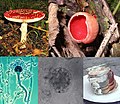Breviatea, commonly known as breviate amoebae, are a group of free-living, amitochondriate protists with uncertain phylogenetic position. They are biflagellate...
10 KB (827 words) - 16:10, 22 September 2023
acronym for Opisthokonta, Breviatea, and Apusomonadidae, the group's three constituent clades. Determining the placement of Breviatea and Apusomonadida and...
7 KB (527 words) - 17:08, 12 September 2024
Sulcozoa, which consists of the subphyla Apusozoa (Apusomonadida and Breviatea), and Varisulca, which includes the subphyla Diphyllatea, Discocelida...
9 KB (1,160 words) - 16:46, 18 June 2024
Opisthokonts, the clade that includes both animals and fungi. Together with the Breviatea, these form the Obazoa clade. Apusomonads are small gliding heterotrophic...
16 KB (1,314 words) - 23:01, 3 June 2024
Diphylleida, it composes the CRuMs clade, positioned closest to Amorphea. Breviatea Cavalier-Smith 2004: includes enigmatic free-living amoeboflagellates...
51 KB (4,923 words) - 03:15, 16 November 2024
multicellularity. Sister groups to Opisthokonta are Apusomonadida (28 species) and Breviatea (4 species). Many smaller lineages do not belong to any of these supergroups...
127 KB (13,200 words) - 12:33, 18 November 2024
Apusomonadida Breviatea Opisthokonta...
42 KB (4,206 words) - 08:08, 9 November 2024
slime molds, and the closely related varioseans, such as Phalansterium. Breviatea, a small class related to animals, fungi and amoebozoans, is composed...
5 KB (1,167 words) - 14:50, 20 May 2024





























